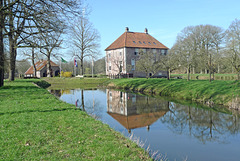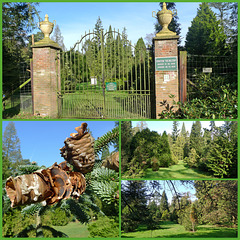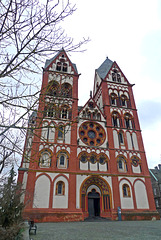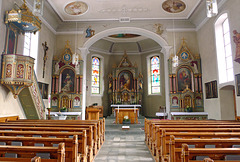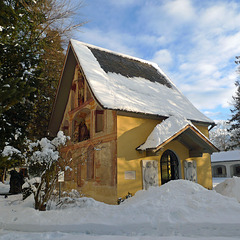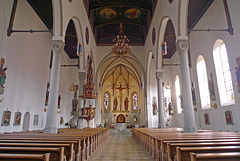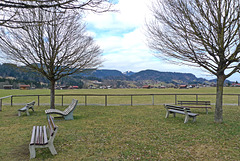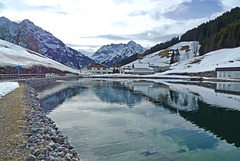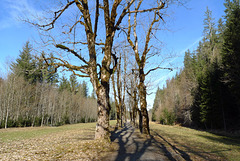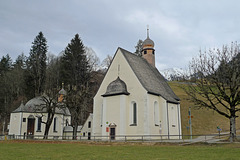Jaap van 't Veen's photos
Nederland - Neede, Havezathe de Kamp
| |
|
|
|
Over the past centuries Havezathe de Kamp (havezathe = manor or fortified (farm) house) has been rebuilt and renovated several times. In 1782 the stepped gables disappeared and in 1871 the canal was filled in and “De Kamp” lost its castle-like appearance.
“Huis De Camp” - as it was originally called - was probably built in the 13th century. In 1469 Johan Van Barmentloo was the first resident whose name we know. In 1553 the house came into the hands of the Gansneb family called Tengnagel. Several generations continued to live there for almost two hundred years. In 1636, Otto Gansneb had Havezathe de Kamp raised and rebuilt into the building as it looks today. The manor was sold in 1741 and subsequently had various owners.
In 1977 the house came into the possession of the municipality of Neede (later Berkelland). Between 1983 and 1989 the manor was restored, the canal was dug out again and the coach house was rebuilt. In 2014, “De Kamp” came into the possession of private owners
After the re-excavation of the moat and the most recent alterations and renovations, Havezathe de Kamp has regained its authentic appearance. Nowadays it is used for business/private meetings and events.
Nederland - Vorden, Pinetum de Belten
| |
|
|
|
Pinetum de Belten is an arboretum with only conifers. This pinetum was founded by Squire Mr. P.R Feith in 1961, when he started collecting pine-trees from all over the world.
Pinetum de Belten is grown from the start to 1400 different types of pine trees. Due to lack of space for so many trees in 1992 the decision was made at around 700 trees to be grubbed up. Sub-tropical trees are removed out of the collection.Nowadayas there are more than 1000 different kinds of trees. Species must be able to grow in this environment. A single exception is made for unique items of the collection.
Since 1974 the pinetum is managed by a foundation. The main goal is to maintain and care for the collection of pine trees. Pinetum de Belten is free to visit, although a voluntary donation is very welcome.
Germany - Limburg an der Lahn
| |
|
|
|
Limburg - developed around a castle from the late 7th century - was first mentioned in documents in the year of 910 as "Lintpurc", when the St. George monastery was founded by Konrad Kurzbold. The town became stone ramparts in the 12th and following centuries. The construction of a new church belonging to St. George monastery started in 1200. Around that time a new castle was built south of the new church.
The plague ravaged Limburg in 1344. The town then underwent a steady decline until the early 19th century, when the rise of the Duchy of Nassau (1806-1866) gave a new lease of life to Limburg. In 1827, Limburg became the seat of a diocese and in 1886 it was made district capital.
Nowadays Limburg's old town offers a maze of cobble stoned streets, lined with crooked half-timbered houses some dating back to the 13th century, but most of them are ‘just’ from the 17th or 18th century.
Germany - Limburg an der Lahn, Limburger Dom
| |
|
|
|
The Limburger Dom (Limburg Cathedral) also known as Georgsdom (George's Cathedral> is one of the best preserved late Romanesque style buildings in Germany. It is unknown when the first church was built on a hill above the Lahn river. Archaeological discoveries have revealed traces of a 9th-century church building in the area of the current chapel. It was probably built in Merovingian times as a castle and the chapel added in the early 9th century.
In 910 AD, Count Konrad Kurzbold founded a collegiate chapter of 18 canons, who lived on the hilltop site. The original castle chapel was torn down and a three-aisled church was built in its place; its foundations have been found beneath the present floor.
The construction of current cathedral is dated to 1180-90. The consecration was performed in 1235 by the archbishop of Trier. Most probably the cathedral was built in four stages. In reference to the seven sacraments, the cathedral also has seven towers.
The interior was destroyed by Swedish soldiers during the Thirty Years War (1618-48) and reconstructed in a late Baroque style in 1749. The church became the rank of cathedral in 1827 when the bishopric of Limburg was founded. In- and exterior have been renovated and restored acouple of times; the last renovation was in the 1980s.
Germany - Weingarten, Basilika St. Martin und Oswa…
| |
|
|
|
The Basilica, which towers on the Martinsberg, is the landmark of Weingarten and the largest baroque church north of the Alps and the second largest church in Germany after the Cathedral of Cologne. It is sometimes called the "Swabian St. Peter's", designed to be one-half the size of the Vatican’s St. Peter's Basilica in Rome.
The Basilica of Weingarten - dedicated to the patron saint of Weingarten, Saint Martin - is an impressive structure that dominates the skyline of Weingarten. The Basilica offers a magnificent baroque architecture and is considered one of the most immaculate examples of baroque buildings in Germany. The interior of the Basilica is as splendid as the exterior, with stunning woodwork and sculptures adorning every corner of the church. The present church was built between 1715 and 1724 in the Italian-German baroque style from architectural plans by Franz Beer.
Austria - Kleinwalsertal/Riezlern, Mariä Opferung
| |
|
|
|
The parish church Mariä Opferung (also called Meine liebe Frau von Jerusalem ) is dating back to the year 1471, visible in the vestibule of the church. In 1493, a gothic-style church was inaugurated and a cemetery was built.
The church was extended in the years1684 and 1720. The tower was raised in 1844 and the pitched roof replaced by a dome. In 1889 the dilapidated church including the tower was demolished and a new, built in the neo-Romanesque style. The ‘new’ church was completed in 1894 and the inauguration took place on June 12 of that year.
Martin von Feuerstein, a well-known Munich professor, created the splendid paintings in casein technique in 1903/1904 with his master class. Twenty years later the Mariä Opferung became a new altar.
Austria - Kleinwalsertal/Hirschegg, Hl. Mutter Ann…
| |
|
|
|
The history of Hl. Mutter Anna (St. Anna parish church) dates back to around 1570, when in Hirschegg a chapel is mentioned, which was then changed and rebuilt several times. The first time the place name was mentioned in the annual diary 1499, where it is recorded in a document: “... located on the hierßegg, dz. picture dar”. As "image" is a shrine or a small chapel to understand.
In 1745 Hirschegg was raised to the chaplaincy. The maternal priest Mittelberg originally filed vehement opposition. Ultimately, the bishop of Constance decided that the pastor has to recognize the appointment of a curate. In 1767 the chapel received a new tower. In 1782 the Hirschegger asked for release from the parish of Mittelberg; ten years later the elevation to an independent parish took place. In 1804, the foundation stone was laid for rebuilding the church. In 1806, the present church was inaugurated by the Bishop of Constance.
Germany - Oberstdorf, Seelenkapelle
| |
|
|
|
The Seelenkapelle (Chapel of the Souls) is one of the few buildings in the center of Oberstdirf, which did not fall victim to the Great Fire of 1865. The chapel is located on the west side of the parish church - in the middle of the old abandoned cemetery - and has been used as a war memorial chapel since 1931. The entrance is therefore guarded by two martial soldiers.
The chapel was probably built in the late 15th century. An "eternal light" was donated to it in 1504. In 1524 it was mentioned as an ossuary. The amazing paintings with the sculptures in the niches on the north wall were created in the middle of the 16th century. The impressive Pietà in the interior is dating back to the early 40s of the 20th century.
The Seelenkapelle is of huge significance to the fallen soldiers from the war and is also considered as a memorial (PiP3). The chapel is the second oldest of the Oberstdorf chapels.
Germany - Rettenberg, Geratser Wasserfall
| |
|
|
|
The Geratser Wasserfall is a striking waterfall in the Kranzegger Bach . It is located south of Kempten and north of Sonthofen in the municipality of Rettenberg. The Kranzegger Bach flows through a green meadow landscape before dropping six meters from a wall in a small wooded area.
The waterfall got its name from the hamlet of Gerats, where it is located. As the waterfall is so hidden in the forest and at the same time a few kilometers away from well known villages, this natural wonder does not attract many visitors.
Germany - Oberstaufen, St. Peter und Paul
| |
|
|
|
The St. Peter und Paul - the catholic parish church of Oberstaufen - was built in 1389 on the ruins of a medieval collegiate church. In its turbulent past, the church saw further destruction when it fell victim to fire at the end of the 17th century and in the 19th century. The present church was built in the neo-Gothic style between 1859 and 1863.
The St. Peter und Paul impresses with a 65 meters high tower with foundations dating back to the 13th century, meter-high statues of the crucifixion group from the late Gothic period and a huge image of St. Christopher on the façade. The ornate pulpit inside the church was also built in the neo-Gothic style in the mid-19th century.
Germany - Oberstdorf, St. Johannes Baptist
| |
|
|
|
St. Johannes Baptist - the parish church of Oberstdorf - stands on the market square in the center of town. The tower with a height of 66 meters - the tallest in the upper Illertal - is the landmark of the town.
The year 991 is mentioned in chronicles as the start of construction of the parish church, but other sources report that this Romanesque church was consecrated in 1141. In 1865, two thirds of Oberstdorf fell victim to the the great fire, including the parish church in the middle of the village; only the surrounding walls and the burnt-out tower remained standing.
The reconstruction of the parish church took place in 1866. The walls of the nave, which were still standing and made of stone masonry could be used again; the nave was raised, extended and provided with a newly built choir. The church was finally reconsecrated in 1872.
Four altars, beautiful pictures and statues adorn the church. The high altar and the people's altar are in the choir room. On the left is the Pentecost altar and on the right the Christmas altar. The church also has a beautiful carved pulpit.
Germany - Oberstdorf, Breitachklamm
| |
|
|
|
The Breitachklamm (Breitach Gorge) was formed only during the last 10,000 years after the “Würm ice age”. Glaciers had eroded soft rocks, and hard rocks remained. When the glaciers had melted, the river Breitach had to grind its way through the hard rocks, over a distance of 2.5 km.
During these years the Breitach has cut a deep canyon into the rocks of the Bavarian Alps, almost on the border between Austria and Germany, just south of Oberstdorf. The most interesting part of the gorge is a couple of hundred meters long. On some places the steep walls are more than 100 meters high, where only very few spots ever get the sunlight.
There is a secured path along the river, which on the narrowest places has been cut into the steep wall of the canyon. All around is water running down the rocks, gurgles in tiny rivers across the hiking trail into the Breitach. On other place waterfalls are coming down from the overhanging walls. The further you enter the gorge, the scene turns into barren rocks with the noise of the powerful water rushing and tumbling metres below the walkway.
Winter 2024 Oberstdorf: Unlike on a previous winter-visit when the walls of the gorge were covered with glittering icicles, ice curtains and frozen waterfalls we were now surprised by waterfalls and a spray of fine droplets and the roaring Breitach beneath us. Water was really everywhere.
Germany - Oberstdorf
| |
|
|
|
The huge village meadow - Öschwiesen - of Oberstdorf is dotted with old barns. Being as flat as a pancake it is an ideal place for walking, biking and in winter for cross country skiing.
Winter 2024 Oberstdorf: No snow, no cross-country skiing, just walkers enjoying the sun and/or the magnificent views of the surrounding Allgäu mountains (snow picture see PiP3). Farmers had already spread manure on the pastures.
Austria - Kleinwalsertal, Rohrsee
| |
|
|
|
The Rohrsee is a water reservoir for the Heuberg ski area.
We passed this artificial lake on a hike along the Untere Höhenweg from the mountain station of the Heuberg lift to Mittelberg. From the path/road, we had beautiful views of Kleinwalsertal (see PiPs).
Austria - Kleinwalsertal, Hoher Ifen
| |
|
|
|
The Hoher Ifen - also called Hochifen - is a 2.230 meters high summit of the Ifen plateau, which is part of the Allgäu Alps. It lies on the border between Austria and Germany and can only be accessed by road from Germany. Hoher Ifen is part of the European Watershed, where water is separated between the North Sea (Rhine River) and the Black Sea (Danube).
This Dolomite-like rock formation with its steep walls is the natural landmark of the Kleinwalsertal. In winter the mountain plateau is an impressive backdrop for the Ifen ski area.
Germany - Oberstdorf, Trettachtal
| |
|
|
|
Trettachtal (Trettach Valley) is one of Oberstdorf’s valleys, which are characterised by glacial drift from the latest ice age. The valley glaciers from the large side valleys gradually crept south, forming the scenery that is visible today. As the glaciers receded, watercourses formed the current valleys, among them the beautiful Trettachtal. The Trettach stream originates south of Oberstdorf near the Trettachspitze and is about 14 km long.
Nowadays the valley - almost car free - offers a more or less level, yet beautiful walk. We often made a round trip during our winter holidays in Oberstdorf. First following the river and passing the hamlets Gruben and Dietersberg, back along the golf course, the frozen Moorweiher and the historic Moorbad swimming pool.
Winter 2024 Oberstdorf: This winter, everything was completely different. There was no snow at all to be seen and the high temperatures made it more spring than winter. It resulted in different pictures than 'normal' (see snow photo of around the same spot in PiP 5).
Germany - Oberstdorf, St. Loretto-Kapellen
| |
|
|
|
The Loretto-Kapellen (Loretto chapels) are a complex of chapels and a fountain on the outskirts of Oberstdorf. It consists of three individual Roman Catholic chapels. The Loretto chapels refer to the Italian pilgrimage site of Loreto near Ancona and are the end point of the Way of the Cross, which starts at the parish church in the village.
The Appachkapelle is the smallest and oldest Loretto chapel. The octagonal building was built in 1493. It is the origin of the entire complex. Today, the church houses a simple marble altar adorned with a wooden sculpture. The little chapel also offers frescoes from the time of its construction (PiP2).
Just outside the chapel stands the Marienbrunnen , which has probably existed since the beginnings of the pilgrimages (PiP1).
The most beautiful and largest chapel is the Kapelle Maria Loretto . It was built when the Appachkapelle became a popular pilgrimage chapel in the 17th century (between 1657 and 1677) and could no longer cope with the large number of pilgrims. It houses the miraculous image of Mary (PiP3 and 4).
The Josefskapelle was built in 1671 on a cross floor plan and consecrated in 1685. This chapel used to form the actual end of the Way of the Cross (PiP5).
Nederland - Ruinen, Echtens Paradijs
| |
|
|
|
Echtens Paradijs (Paradise of Echten) is a 1,200-hectare nature reserve in the Ruinen forestry area. Originally virgin and inaccessible, the area was planted with coniferous forests in the 1930s; nowadays, these are increasingly being replaced by broad-leaved forests. Another part of the area consists of heathland, shifting sands and fens.
Jump to top
- ipernity © 2007-2024
- Help & Contact
|
Club news
|
About ipernity
|
History |
ipernity Club & Prices |
Guide of good conduct
Donate | Group guidelines | Privacy policy | Terms of use | Statutes | In memoria -
Facebook
Twitter

